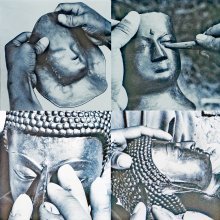Charcoal: 1 definition
Introduction:
Charcoal means something in Hinduism, Sanskrit. If you want to know the exact meaning, history, etymology or English translation of this term then check out the descriptions on this page. Add your comment or reference to a book if you want to contribute to this summary article.
Images (photo gallery)
In Hinduism
Shilpashastra (iconography)
Source: Shodhganga: Elements of Art and Architecture in the Trtiyakhanda of the Visnudharmottarapurana (shilpa)Charcoal is associated with Agni (Vahni), whose iconography is described in the Viṣṇudharmottarapurāṇa, an ancient Sanskrit text which (being encyclopedic in nature) deals with a variety of cultural topics such as arts, architecture, music, grammar and astronomy.—In the agnisūkta of Ṛgveda, Agni is called as Aṅgiras. Explaining the aṅgiras term Aitareyabrāhmaṇa says that aṅgiras is that which possesses aṅgāra i.e., charcoal. Charcoal in heated form is red in colour. So it can be assumed that following this concept of the Ṛgveda, the Viṣṇudharmottarapurāṇa suggests red colour as the body complexion of the image of Agni Thus it is clear that the Viṣṇudharmottarapurāṇa offers a great field of knowledge regarding the nuances of Indian art of Image making [e.g., charcoal] during 10th–11th century A.D.

Shilpashastra (शिल्पशास्त्र, śilpaśāstra) represents the ancient Indian science (shastra) of creative arts (shilpa) such as sculpture, iconography and painting. Closely related to Vastushastra (architecture), they often share the same literature.
See also (Relevant definitions)
Starts with: Charcoal tree.
Full-text (+194): Angara, Angaraka, Nidhapaka, Vyangara, Angarya, Kolasa, Lonari, Jitakolasa, Shikhi, Kokila, Masi, Golakarmi, Charcoal tree, Blacksmiths' charcoal wood, Jita Kolasa, Indian charcoal tree, Samtapta, Iddaliga, Karvanna, Mashicitra.
Relevant text
Search found 97 books and stories containing Charcoal; (plurals include: Charcoals). You can also click to the full overview containing English textual excerpts. Below are direct links for the most relevant articles:
Sahitya-kaumudi by Baladeva Vidyabhushana (by Gaurapada Dāsa)
Text 10.32 < [Chapter 10 - Ornaments of Meaning]
The Great Chronicle of Buddhas (by Ven. Mingun Sayadaw)
Biography (12) Kisāgotamī Therī < [Chapter 44 - Life Histories of Bhikkhunī Arahats]
Part 8 - Story of Candābha Thera < [Chapter 35 - Story of Māra]
Moggallāna Mahāthera’s Attainment of Parinibbāna < [Chapter 43 - Forty-one Arahat-Mahatheras and their Respective Etadagga titles]
The Padma Purana (by N.A. Deshpande)
Chapter 16 - The Death & Post-mortem State of Sinners < [Section 2 - Bhūmi-khaṇḍa (section on the earth)]
Chapter 8 - The Love Story of Indra and Padmagandhā < [Section 7 - Kriyāyogasāra-Khaṇḍa (Section on Essence of Yoga by Works)]
Chapter 70 - Sinners in Hell < [Section 2 - Bhūmi-khaṇḍa (section on the earth)]
Nitiprakasika (Critical Analysis) (by S. Anusha)
Dantakaṇṭaka (Tooth-Thorn) < [Chapter 3]
Sarga IV: Muktāyudha-nirūpaṇa (52 Verses) < [Chapter 2]
Rasa Jala Nidhi, vol 1: Initiation, Mercury and Laboratory (by Bhudeb Mookerjee)
Part 2 - Alchemical crucibles (musa) < [Chapter VI - Laboratory equipment]
Part 1 - Alchemical apparatus (yantra) < [Chapter VI - Laboratory equipment]
Part 1 - Additional process for transformation of base metals into gold and silver < [Chapter VIII - Conclusion of first volume]
The Brahmanda Purana (by G.V. Tagare)
Chapter 1 - Birth of seven sages (saptarṣi): Race of Bhṛgu and Aṅgiras < [Section 3 - Upodghāta-pāda]
Related products


